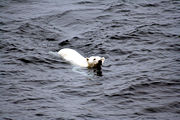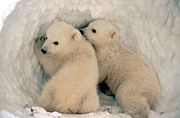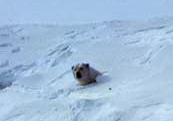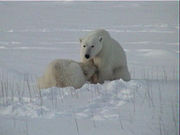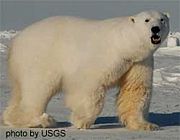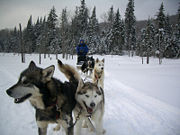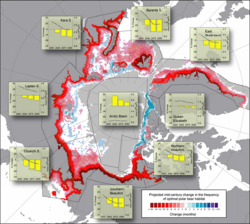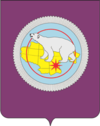Polar bear
2008/9 Schools Wikipedia Selection. Related subjects: Mammals
| Polar Bear | ||||||||||||||||
|---|---|---|---|---|---|---|---|---|---|---|---|---|---|---|---|---|
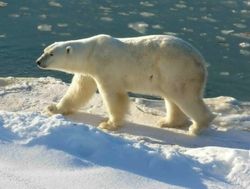 |
||||||||||||||||
| Conservation status | ||||||||||||||||
| Scientific classification | ||||||||||||||||
|
||||||||||||||||
| Binomial name | ||||||||||||||||
| Ursus maritimus Phipps, 1774 |
||||||||||||||||
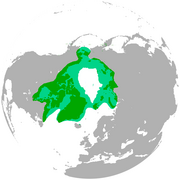 Polar bear range
|
||||||||||||||||
| Synonyms | ||||||||||||||||
|
Ursus eogroenlandicus |
The polar bear (Ursus maritimus) is a bear native to the Arctic Ocean and its surrounding seas. The world's largest predator found on land, an adult male weighs around 400–680 kg (880–1,500 lb), while an adult female is about half that size. Although it is closely related to the brown bear, it has evolved to occupy a narrow ecological niche, with many body characteristics adapted for cold temperatures, for moving across snow, ice, and open water, and for hunting the seals which make up most of its diet. As it can hunt consistently only from sea ice, the polar bear spends much of the year on the frozen sea, although most polar bears are born on land.
The polar bear is classified as a vulnerable species. Of the 19 recognized polar bear subpopulations, 5 are declining, 5 are stable, 2 are increasing, and 7 have insufficient data. For decades, unrestricted hunting raised international concern for the future of the species; populations have rebounded after controls and quotas began to take effect. For thousands of years, the polar bear has been a key figure in the material, spiritual, and cultural life of Arctic indigenous peoples, and the hunting of polar bears remains important in their cultures.
The IUCN now lists global warming as the most significant threat to the polar bear, primarily because the melting of its sea ice habitat reduces its ability to find sufficient food. Sea ice melting will also cause changes in their mating, and traveling patterns. The IUCN states, "If climatic trends continue polar bears may become extirpated from most of their range within 100 years." On 14 May 2008, the United States Department of the Interior listed the polar bear as a threatened species under the Endangered Species Act.
Naming and etymology
Constantine John Phipps was the first to describe the polar bear as a distinct species. He chose the scientific name Ursus maritimus, the Latin for 'maritime bear', due to the animal's native habitat. The Inuit refer to the animal as nanook, ( transliterated as nanuuq in the Inupiat language, nanuuk in Siberian Yupik, and also as nanuq or nanuk; and hence the title of the early 20th century documentary on Inuit life, Nanook of the North). The bear is umka in the Chukchi language. In Russian, it is usually called Белый Медведь (Bely Medved, the White Bear), though an older word still in use is Ошкуй (Oshkuy, which comes from the Komi Oski, "bear"). In Quebec French, the polar bear is referred to as Ours polaire.
The polar bear was previously considered to be in its own genus, Thalarctos. However, evidence of hybrids between polar bears and brown bears, and of the relatively recent evolutionary divergence of the two species, does not support the establishment of this separate genus, and the accepted scientific name is now therefore Ursus maritimus, as Phipps originally proposed.
Taxonomy and evolution

The bear family, Ursidae, is believed to have split off from other carnivorans about 38 million years ago. The Ursinae subfamily originated approximately 4.2 million years ago. According to both fossil and DNA evidence, the polar bear diverged from the brown bear, Ursus arctos, roughly 200,000 years ago. The oldest known polar bear fossil is less than 100,000 years old. Fossils show that between ten to twenty thousand years ago, the polar bear's molar teeth changed significantly from those of the brown bear. Polar bears are thought to have diverged from a population of brown bears that became isolated during a period of glaciation in the Pleistocene.
More recent genetic studies have shown that some clades of brown bear are more closely related to polar bears than to other brown bears, meaning that the polar bear is not a true species according to some species concepts. In addition, polar bears can breed with brown bears to produce fertile grizzly–polar bear hybrids, indicating that they have only recently diverged and are genetically similar. However, as neither species can survive long in the other's ecological niche, and with distinctly different morphology, metabolism, social and feeding behaviors, and other phenotypic characteristics, the two bears are generally classified as separate species.
When the polar bear was originally documented, two subspecies were identified: Ursus maritimus maritimus by Constantine J. Phipps in 1774, and Ursus maritimus marinus by Peter Simon Pallas in 1776. This distinction has since been invalidated.
One fossil subspecies has been identified. Ursus maritimus tyrannus—descended from Ursus arctos—became extinct during the Pleistocene. U.m. tyrannus was significantly larger than the living subspecies.
Population and distribution
The polar bear is found throughout the Arctic Ocean and adjacent seas. Due to the absence of human development in its remote habitat, it retains more of its original range than any other extant large carnivore. While they are rare north of 88°, there is evidence that they range all the way across the Arctic, and as far south as James Bay in Canada. They can occasionally drift widely with the sea ice, and there have been anecdotal sightings as far south as Berlevåg on the Norwegian mainland and the Kuril Islands in the Sea of Okhotsk. It is difficult to estimate a global population of polar bears as much of the range has been poorly studied, however biologists use a working estimate of about 20,000-25,000 polar bears worldwide.
There are 19 generally recognized discrete subpopulations. The subpopulations display seasonal fidelity to particular areas, but DNA studies show that they are not reproductively isolated. The thirteen North American subpopulations range from the Beaufort Sea south to Hudson Bay and east to Baffin Bay in western Greenland and account for about 70% of the global population. The Eurasian population is broken up into the East Greenland, Barents Sea, Kara Sea, Laptev Sea, and Chukchi Sea subpopulations, though there is considerable uncertainty about the structure of these populations due to limited mark and recapture data.
The range includes the territory of five nations: Denmark (Greenland), Norway (Svalbard), Russia, US ( Alaska) and Canada. These five nations are the signatories of the 1973 International Agreement for the Conservation of Polar Bears which mandates cooperation on research and conservations efforts throughout the polar bear's range.
Modern methods of tracking polar bear populations have been implemented only since the mid-1980s, and are expensive to perform consistently over a large area. The most accurate counts require flying a helicopter in the Arctic climate to find polar bears, shooting a tranquilizer dart at the bear to sedate it, and then tagging the bear. In Nunavut, some Inuit have reported increases in bear sightings around human settlements in recent years, leading to a belief that populations are increasing. Scientists have responded by noting that hungry bears may be congregating around human settlements, leading to the illusion that populations are higher than they actually are. The Polar Bear Specialist Group of the IUCN takes the position that "estimates of subpopulation size or sustainable harvest levels should not be made solely on the basis of traditional ecological knowledge without supporting scientific studies."
Of the 19 recognized polar bear subpopulations, 5 are declining, 5 are stable, 2 are increasing, and 7 have insufficient data.
Habitat
The polar bear is often regarded as a marine mammal because it spends many months of the year at sea. Its preferred habitat is the annual sea ice (that is, ice that melts for part of the year) covering the waters over the continental shelf and the Arctic inter-island archipelagos. These areas have relatively high biological productivity in comparison to the deep waters of the high Arctic. The polar bear tends to frequent areas of open water, such as polynyas and leads (temporary stretchs of open water in Arctic ice) to hunt the seals that make up most of its diet. Polar bears are therefore found primarily along the perimeter of the polar ice pack, rather than in the Polar Basin close to the North Pole where the density of seals is low.
Annual ice contains areas of water that appear and disappear throughout the year as the weather changes. Seals migrate in response to these changes, and polar bears must follow their prey. In Hudson Bay, James Bay, and some other areas, the ice melts completely each summer (an event often referred to as "ice-floe breakup"), forcing polar bears to go onto land and wait through the months until the next freeze-up. In the Chukchi and Beaufort seas, polar bears retreat to the multi-year ice (that is, ice that remains solid year-round) further north each summer.
Biology and behaviour
Physical characteristics
The polar bear is the largest predator that lives on land, being twice as big as the Siberian Tiger. Adult males weigh 352–680 kg (780–1,500 lb) and measure 2.4–3 m (7.9–9.8 ft) in length. Adult females are roughly half the size of males and normally weigh 150–249 kg (330–550 lb), measuring 1.8–2.4 metres (5.9–7.9 ft) in length. When pregnant, however, they can weigh as much as 499 kg (1,100 lb). The polar bear is among the most sexually dimorphic of mammals, surpassed only by the eared seals. The largest polar bear on record, reportedly weighing 1,002 kg (2,210 lb), was a male shot at Kotzebue Sound in northwestern Alaska in 1960.
Compared with its closest relative, the brown bear, the polar bear has a more elongated body build and a longer skull and nose. As predicted by Allen's rule for a northerly animal, the legs are stocky and the ears and tail are small. However, the feet are very large to distribute load when walking on snow or thin ice and to provide propulsion when swimming; they may measure 36 cm (12 in) across in an adult. The pads of the paws are covered with small, soft papillae which provide traction on the ice. The polar bear's claws are short and stocky compared to those of the brown bear, perhaps to serve the former's need to grip heavy prey and ice. The claws are deeply scooped on the underside to assist in digging in the ice of the natural habitat. Despite a recurring internet meme that all polar bears are left-handed, there is no scientific evidence to support this claim.
The 42 teeth of a polar bear reflect its highly carnivorous diet. The cheek teeth are smaller and more jagged than in the brown bear, and the canines are larger and sharper. The dental formula is:
| 3.1.4.2 |
| 3.1.4.3 |
Polar bear fur consists of a layer of dense underfur and an outer layer of guard hairs, which appear white to tan but are actually transparent. The guard hair is 5–15 cm (2.0–5.9 in) over most of the body.
Polar bears are superbly insulated by their 10 cm (3.9 in) of blubber, their hide and their fur; they overheat at temperatures above 10 °C (50 °F), and are nearly invisible under infrared photography.
Polar bears gradually moult from May to August, but, unlike other Arctic mammals, they do not shed their coat for a darker shade to camouflage themselves in the summer conditions. The hollow guard hairs of a polar bear coat were once thought to act as fibre-optic tubes to conduct light to its black skin, where it could be absorbed; however, this theory was disproved by recent studies. The white coat usually yellows with age. When kept in captivity in warm, humid conditions, it is not unknown for the fur to turn a pale shade of green due to algae growing inside the guard hairs. Males have significantly longer hairs on their forelegs, that increase in length until the bear reaches 14 years of age. The male's ornamental foreleg hair is thought to attract females, serving a similar function to the lion's mane.
The polar bear has an extremely well-developed sense of smell, being able to detect seals nearly 1 mi (1.6 km) away and buried under 3 ft (0.91 m) of snow. Its hearing is about as acute as that of a human, and its vision is also good at long distances.
Polar bears are excellent swimmers and have been seen in open Arctic waters as far as 200 mi (320 km) from land. Their 12 cm (4.7 in) layer of fat adds buoyancy and insulates them from the cold. Polar bears can swim 6 miles/hour.
Polar bears still have a vestigial hibernation induction trigger in their blood, but they do not hibernate in the winter as the brown bear does. Only female polar bears enter a dormant state (referred to as "denning") during pregnancy, though their body temperature does not decrease during this period as it would for a typical mammal in hibernation.
Hunting and diet
The polar bear is the most carnivorous member of the bear family, and most of its diet consists of Ringed and Bearded Seals. The Arctic is home to millions of seals, which become prey when they surface in holes in the ice in order to breathe, or when they haul out on the ice to rest. Polar bears hunt primarily at the interface between ice, water, and air; they only rarely catch seals on land or in open water.
The polar bear's most common hunting method is called still-hunting: The bear uses its excellent sense of smell to locate a seal breathing hole, and crouches nearby in silence for a seal to appear. When the seal exhales, the bear smells its breath, reaches into the hole with a forepaw, and drags it out onto the ice. The polar bear kills the seal by biting its head to crush its skull. The polar bear also hunts by stalking seals resting on the ice: Upon spotting a seal, it walks to within 100 yd (91 m), and then crouches. If the seal does not notice, the bear creeps to within 30 to 40 feet (9.1 to 12 m) of the seal and then suddenly rushes forth to attack. A third hunting method is to raid the birth lairs that female seals create in the snow.
A widespread legend tells that polar bears cover their black noses with their paws when hunting. This behaviour, if it happens, is rare — although the story exists in native oral history and in accounts by early Arctic explorers, there is no record of an eyewitness account of the behaviour in recent decades.
Mature bears tend to eat only the calorie-rich skin and blubber of the seal, whereas younger bears consume the protein-rich red meat. For subadult bears which are independent of their mother but have not yet gained enough experience and body size to successfully hunt seals, scavenging the carcasses from other bears' kills is an important source of nutrition. Subadults may also be forced to accept a half-eaten carcass if they kill a seal but cannot defend it from larger polar bears. After feeding, polar bears wash themselves with water or snow.
The polar bear is an enormously powerful predator. It can kill an adult walrus, although it rarely attempts to as a walrus can be more than twice the bear's weight. However, most terrestrial animals can outrun the polar bear on land as polar bears overheat quickly, and most marine animals can outswim it. In some areas, the polar bear's diet is supplemented by walrus calves, by whales captured at breathing holes, and by the carcasses of dead adult walruses or whales, whose blubber is readily devoured even when rotten.
When sea ice is unavailable during summer and early autumn, some populations live off fat reserves for months at a time. Polar bears have also been observed to eat a wide variety of other wild foods, including muskox, reindeer, birds, eggs, rodents, shellfish, crabs, and other polar bears. They may also eat plants, including berries, roots, and kelp, however none of these are a significant part of their diet. The polar bear's biology is specialized to require large amounts of fat from marine mammals, and it cannot derive sufficient caloric intake from terrestrial food. They are the only animal known to hunt humans for food.
Being both curious animals and scavengers, polar bears investigate and consume garbage where they come into contact with humans. This was documented at the dump in Churchill, Manitoba before its closure. Polar bears may attempt to consume almost anything they can find, including hazardous substances such as styrofoam, plastic, car batteries, ethylene glycol, hydraulic fluid, and motor oil. The Churchill dump was closed in 2006 to protect the bears, and waste is now recycled or transported to Thompson, Manitoba.
Behaviour
Unlike grizzly bears, polar bears are not territorial. Although stereotyped as being voraciously aggressive, they are normally cautious in confrontations, and often choose to escape rather than fight. Fat polar bears rarely attack humans unless severely provoked, whereas hungry polar bears are extremely unpredictable and are known to kill and sometimes eat humans. Polar bears are stealth hunters, and the victim is often unaware of the bear's presence until the attack is underway. Whereas brown bears often maul a person and then leave, polar bear attacks are almost always fatal.
In general, adult polar bears live solitary lives. Yet, they have often been seen playing together for hours at a time and even sleeping in an embrace, and polar bear zoologist Nikita Ovsianikov has described adult males as having "well-developed friendships." Cubs are especially playful as well. Among young males in particular, play-fighting may be a means of practicing for serious competition during mating seasons later in life.
In 1992, a photographer near Churchill took a now widely-circulated set of photographs of a polar bear playing with a Canadian Eskimo Dog a tenth of its size. The pair wrestled harmlessly together each afternoon for ten days in a row for no apparent reason, although the bear may have been trying to demonstrate its friendliness in the hope of sharing the kennel's food. This kind of social interaction is uncommon; it is far more typical for polar bears to behave aggressively towards dogs.
Reproduction and lifecycle
Courtship and mating take place on the sea ice in April and May, when polar bears congregate in the best seal hunting areas. A male may follow the tracks of a breeding female for 100 km (62 mi) or more, and after finding her engage in intense fighting with other males over mating rights, fights which often result in scars and broken teeth. Polar bears have a generally polygynous mating system, however recent genetic testing of mothers and cubs has uncovered cases of litters in which cubs have different fathers. Partners stay together and mate repeatedly for an entire week; the mating ritual induces ovulation in the female.
After mating, the fertilized egg remains in a suspended state until August or September. During these four months, the pregnant female eats prodigious amounts of food, gaining at least 200 kg (440 lb) and often more than doubling her body weight.
Maternity denning and early life
When the ice floes break up in the fall, ending the possibility of hunting, each pregnant female digs a maternity den consisting of a narrow entrance tunnel leading to one to three chambers. Most maternity dens are in snowdrifts, but may also be made underground in permafrost if it is not sufficiently cold yet for snow. In most subpopulations, maternity dens are situated on land a few kilometers from the coast, and the individuals in a subpopulation tend to reuse the same denning areas each year. The polar bears that do not den on land make their dens on the sea ice. In the den, she enters a dormant state similar to hibernation. This hibernation-like state does not consist of continuous sleeping, however the bear's heart rate slows from 46 to 27 beats per minute.
Between November and February, cubs are born blind, covered with a light down fur, and weighing less than 0.9 kg (2.0 lb). On average, each litter has two cubs. The family remains in the den until mid-February to mid-April, with the mother maintaining her fast while nursing her cubs on a fat-rich milk. By the time the mother breaks open the entrance to the den, her cubs weigh about 10 to 15 kilograms (22 to 33 lb). For about 12 to 15 days, the family spends time outside the den while remaining in its vicinity, the mother grazing on vegetation while the cubs become used to walking and playing. Then they begin the long walk from the denning area to the sea ice, where the mother can once again catch seals. Depending on the timing of ice-floe breakup in the fall, she may have fasted for up to eight months.
Cubs may fall prey to wolves, to adult male polar bears, or to starvation. Female polar bears are noted for both their affection towards their offspring, and their valiance in protecting them. One case of adoption of a wild cub has been confirmed by genetic testing. Adult male bears are perhaps the biggest threat to bear cubs. Some infanticidal males have been observed consuming their victims. In Alaska, 42% of cubs now reach 12 months of age, down from 65% 15 years ago. In most areas, cubs are weaned at two and a half years of age, when the mother chases them away or abandons them. The western coast of Hudson Bay is unusual in that its female polar bears sometimes wean their cubs at only one and a half years. This was the case for 40% of cubs in western Hudson Bay in the early 1980s, however by the 1990s, fewer than 20% of cubs were weaned this young. After the mother leaves, sibling cubs sometimes travel and share food together for weeks or months.
Later life
Females begin to breed at the age of four years in most areas, and five years in the Beaufort Sea area. Males usually reach sexual maturity at six years, however as competition for females is fierce, many do not breed until the age of eight or ten. A study in Hudson Bay indicated that both the reproductive success and the maternal weight of females peaked in their mid-teens.
Polar bears are especially susceptible to Trichinella, a parasitic roundworm they contract through cannibalism. Bacterial Leptospirosis, rabies and Morbillivirus have been recorded. The bears are thought by some to be more resistant than other carnivores to viral disease. Polar bears sometimes have problems with various skin diseases which may be caused by mites or other parasites.
Polar bears rarely live beyond 25 years. The oldest wild bears on record died at the age of 32, whereas the oldest captive was a female who died in 1991 at the age of 43. The oldest living polar bear is Debby of the Assiniboine Park Zoo, who was probably born in December, 1966.
Ecological role
The polar bear is the apex predator within its range. Several animal species, particularly Arctic Foxes and Glaucous Gulls, routinely scavenge polar bear kills.
The relationship between ringed seals and polar bears is so close that the abundance of ringed seals in some areas appears to regulate the density of polar bears, while polar bear predation in turn, regulates density and reproductive success of ringed seals. The evolutionary pressure of polar bear predation on seals probably accounts for some significant differences between Arctic and Antarctic seals. Compared to the Antarctic, where there is no major surface predator, Arctic seals use more breathing holes per individual, appear more restless when hauled out on the ice, and rarely defecate on the ice. The baby fur of most Arctic seal species is white, presumably to provide camouflage from predators, whereas Antarctic seals all have dark fur at birth.
Exploitation
Indigenous people
Polar bears have long provided important raw materials for Arctic peoples, including the Inuit, Yupik, Chukchi, Nenets, Russian Pomors and others. Almost all parts of captured animals had a use. The fur was used in particular to sew pants and, by the Nenets, to make galoshes-like outer footwear called tobok; the meat is edible, despite some risk of trichinosis; the fat was used in food and as a fuel for lighting homes, alongside seal and whale blubber; sinews were used as thread for sewing clothes; the gallbladder and sometimes heart were dried and powdered for medicinal purposes; the large canine teeth were highly valued as talismans. Only the liver was not used, as its high concentration of vitamin A is poisonous. Hunters make sure to either toss the liver into the sea or bury it in order to spare their dogs from potential poisoning. Traditional subsistence hunting was on a small enough scale to not significantly affect polar bear populations, mostly because of the sparseness of the human population in polar bear habitat.
History of commercial harvest
In Russia, polar bear furs were already being commercially traded in the 14th century, though it was of relatively low value compared to Arctic Fox or even reindeer fur. The growth of the human population in the Eurasian Arctic in the 16th and 17th century, together with the advent of firearms and increasing trade, dramatically increased the harvest of polar bears. However, since polar bear fur has always played a marginal commercial role, data on the historical harvest is fragmentary. It is known, for example, that already in the winter of 1784/1785 Russian Pomors on Spitsbergen harvested 150 polar bears on Magdalena fjord. In the early 20th century, Norwegian hunters were harvesting 300 bears a year at the same location. Estimates of total historical harvest suggest that from the beginning of the 18th century, roughly 400-500 animals were being harvested annually in northern Eurasia, reaching a peak of 1,300 to 1,500 animals in the early 20th century, and falling off as the numbers began dwindling.
In the first half of the 20th century, mechanized and overpoweringly efficient methods of hunting and trapping came into use in North America as well. Polar bears were chased from snowmobiles, icebreakers, and airplanes, the latter practice described in a 1965 New York Times editorial as being "about as sporting as machine gunning a cow." The numbers taken grew rapidly in the 1960s, peaking around 1968 with a global total of 1,250 bears that year.
Contemporary regulations
Concerns over the future survival of the species led to the development of national regulations on polar bear hunting, beginning in the mid-1950s. In 1973, the International Agreement on the Conservation of Polar Bears was signed by all five nations whose territory is inhabited by polar bears (Canada, Denmark (Greenland), Norway (Svalbard), the USSR (now the Russian Federation) and the USA (Alaska)). Also known as the Oslo Agreement, it was a rare case of international cooperation during the Cold War. Biologist Ian Stirling commented, "For many years, the conservation of polar bears was the only subject in the entire Arctic that nations from both sides of the Iron Curtain could agree upon sufficiently to sign an agreement. Such was the intensity of human fascination with this magnificent predator, the only marine bear."
Although the agreement is not enforceable in itself, member countries agreed to place restrictions on recreational and commercial hunting, ban hunting from aircraft and icebreakers, and conduct further research. The treaty allows hunting "by local people using traditional methods," although this has been liberally interpreted by member nations. Norway is the only country of the five in which all harvest of polar bears is banned.
Agreements have been made between countries to co-manage their shared polar bear subpopulations. After several years of negotiations, Russia and the U.S. signed an agreement in October 2000 to jointly set quotas for indigenous subsistence hunting in Alaska and Chukotka. The treaty was ratified in October 2007.
Russia
The Soviet Union banned all harvest of polar bears in 1956, however poaching continued and is believed to pose a serious threat to the polar bear population. In recent years, polar bears have approached coastal villages in Chukotka more frequently due to the shrinking of the sea ice, endangering humans and raising concerns that illegal hunting would become even more prevalent. In 2007, the Russian government made subsistence hunting legal for Chukotka natives only, a move supported by Russia’s most prominent bear researchers and the World Wide Fund for Nature as a means to curb poaching.
Greenland
In Greenland, restrictions for the species were first introduced in 1994 and expanded by executive order in 2005. Until 2005, Greenland placed no limit on hunting by indigenous people. It imposed a limit of 150 for 2006. It also allowed recreational hunting for the first time. Other provisions included year-round protection of cubs and mothers, restrictions on weapons used, and various administrative requirements to catalogue kills.
Canada and the United States
About 500 bears are killed per year by humans across Canada, a rate believed by scientists to be unsustainable for some areas, notably Baffin Bay. Canada has allowed sport hunters accompanied by local guides and dog-sled teams since 1970, but the practice was not common until the 1980s. The guiding of sport hunters provides meaningful employment and an important source of income for native communities in which economic opportunities are few. Sport hunting can bring CDN$20,000 to $35,000 per bear into northern communities, which until recently has been mostly from American hunters.
On 15 May 2008, the U.S. listed the polar bear as a threatened species under the Endangered Species Act, and banned all importing of polar bear trophies. Importing products made from polar bears had been prohibited from 1972 to 1994 under the Marine Mammal Protection Act, and restricted between 1994 and 2008. Under those restrictions, permits from the United States Fish and Wildlife Service were required to import sport-hunted polar bear trophies taken in hunting expeditions in Canada. The permit process required that the bear be taken from an area with quotas based on sound management principles. Since 1994, more than 800 sport-hunted polar bear trophies have been imported into the U.S.
Ironically, because of the way polar bear hunting quotas are managed in Canada, attempts to discourage sport hunting would actually increase the number of bears killed in the short term. Canada allocates a certain number of permits each year to sport and subsistence hunting, and those that are not used for sport hunting are re-allocated to native subsistence hunting. Approximately 50% of sport hunters with permits actually kill a polar bear, whereas for subsistence hunters the success rate is 100%.
The territory of Nunavut accounts for 80% of Canadian kills. In 2005, the government of Nunavut increased the quota from 400 to 518 bears, despite protests from some scientific groups. In two areas where harvest levels have been increased based on increased sightings, science-based studies have indicated declining populations, and a third area is considered data-deficient. While most of that quota is hunted by the indigenous Inuit people, a growing share is sold to recreational hunters. (0.8% in the 1970s, 7.1% in the 1980s, and 14.6% in the 1990s) Nunavut polar bear biologist, M.K. Taylor, who is responsible for polar bear conservation in the territory, insists that bear numbers are being sustained under current hunting limits. The Government of the Northwest Territories maintain their own quota of 72–103 bears within the Inuvialuit communities of which some are set aside for sports hunters.
Conservation status, efforts and controversies
The global polar bear population, estimated to be 22,000-25,000 bears, is relatively stable. However, in 2006, the World Conservation Union (IUCN) upgraded the polar bear from a species of Least Concern to a vulnerable species. It cited a "suspected population reduction of >30% within three generations (45 years)", due primarily to global warming. Other risks to the polar bear include pollution in the form of toxic contaminants, conflicts with shipping, stresses from recreational polar-bear watching, and oil and gas exploration and development. The IUCN also cited a "potential risk of over-harvest" through legal and illegal hunting.
Global warming
The IUCN, Arctic Climate Impact Assessment, United States Geological Survey and many leading polar bear biologists have expressed grave concerns about the impact of global warming, including the belief that the current warming trend imperils the survival of the species.
The key danger posed by global warming is malnutrition or starvation due to habitat loss. Polar bears hunt seals from a platform of sea ice. Rising temperatures cause the sea ice to melt earlier in the year, driving the bears to shore before they have built sufficient fat reserves to survive the period of scarce food in the late summer and early fall. Reduction in sea-ice cover also forces bears to swim longer distances, which further depletes their energy stores and occasionally leads to drowning. Thinner sea ice tends to deform more easily, which appears to make it more difficult for polar bears to access seals. Insufficient nourishment leads to lower reproductive rates in adult females and lower survival rates in cubs and juvenile bears, in addition to poorer body condition in bears of all ages.
In addition to creating nutritional stress, a warming climate is expected to affect various other aspects of polar bear life: Changes in sea ice affect the ability of pregnant females to build suitable maternity dens. As the distance increases between the pack ice and the coast, females must swim longer distances to reach favored denning areas on land. Thawing of permafrost would affect the bears who traditionally den underground, and warm winters could result in den roofs collapsing or having reduced insulative value. For the polar bears that currently den on multi-year ice, increased ice mobility may result in longer distances for mothers and young cubs to walk when they return to seal-hunting areas in the spring. Disease-causing bacteria and parasites would flourish more readily in a warmer climate.
Negative interactions between polar bears and humans, such as bears foraging in garbage dumps, have historically been more prevalent in years when ice-floe breakup occurred early and polar bears were relatively thin. Increased human-bear interactions, including fatal attacks on humans, are likely to increase as the sea ice shrinks and hungry bears try to find food on land.
Observations linked to global warming
The effects of global warming are most profound in the southern part of the polar bear's range, and this is indeed where significant degradation of local populations has been observed. The Western Hudson Bay subpopulation, in a southern part of the range, also happens to be one of the best-studied polar bear subpopulations. This subpopulation feeds heavily on ringed seals in late spring, when newly-weaned and easily hunted seal pups are abundant. The late spring hunting season ends for polar bears when the ice begins to melt and break up, and they fast or eat little during the summer until the sea freezes again.
Due to warming air temperatures, ice-floe breakup in western Hudson Bay is currently occurring three weeks earlier than it did 30 years ago, reducing the duration of the polar bear feeding season. The body condition of polar bears has declined during this period; the average weight of lone (and likely pregnant) female polar bears was approximately 290 kg (640 lb) in 1980 and 230 kg (510 lb) in 2004. Between 1987 and 2004, the Western Hudson Bay population declined by 22%.
In Alaska, the effects of sea ice shrinkage have contributed to higher mortality rates in polar bear cubs, and have led to changes in the denning locations of pregnant females. Recently, polar bears in the Arctic have undertaken longer than usual swims to find prey, resulting in four recorded drownings in the unusually large ice pack regression of 2005.
Predictions
The U.S. Geological Survey predicts two-thirds of the world's polar bears will disappear by 2050, based on moderate projections for the shrinking of summer sea ice caused by global warming. The bears would disappear from Europe, Asia, and Alaska, and be depleted from the Arctic archipelago of Canada and areas off the northern Greenland coast. By 2080, they would disappear from Greenland entirely and from the northern Canadian coast, leaving only dwindling numbers in the interior Arctic archipelago.
Predictions vary on the extent to which polar bears could adapt to climate change by switching to terrestrial food sources. Mitchell Taylor, the director of Wildlife Research for the Government of Nunavut, wrote to the US Fish and Wildlife Service arguing that local studies are insufficient evidence for global protection at this time. The letter stated, "At present, the polar bear is one of the best managed of the large Arctic mammals. If all Arctic nations continue to abide by the terms and intent of the Polar Bear Agreement, the future of polar bears is secure.... Clearly polar bears can adapt to climate change. They have evolved and perisisted for thousands of years in a period characterized by fluctuating climate." Ken Taylor, deputy commissioner for the Alaska Department of Fish and Game, has said, "I wouldn't be surprised if polar bears learned to feed on spawning salmon like grizzly bears."
However, many scientists consider these theories to be naive; it is noted that black and brown bears at high latitudes are smaller than elsewhere, because of the scarcity of terrestrial food resources. An additional risk to the species is that if individuals spend more time on land, they will hybridize with brown or grizzly bears. The IUCN wrote:
| “ | Polar bears exhibit low reproductive rates with long generational spans. These factors make facultative adaptation by polar bears to significantly reduced ice coverage scenarios unlikely. Polar bears did adapt to warmer climate periods of the past. Due to their long generation time and the current greater speed of global warming, it seems unlikely that polar bear will be able to adapt to the current warming trend in the Arctic. If climatic trends continue polar bears may become extirpated from most of their range within 100 years. | ” |
Pollution
Polar bears accumulate high levels of artificial halocarbons such as polychlorinated biphenyl (PCBs) and pesticides because of their diet. Their position at the top of the food pyramid tends to concentrate pollutants, particularly halocarbons because of their lipophilicity: halocarbons are soluble in the blubber which makes up the bulk of the polar bear's diet. Halocarbons are known to be toxic to other animals because they mimic hormone chemistry, and biomarkers such as immunoglobulin G and retinol suggest similar effects on polar bears. The overall significance to population health is uncertain because of unique features of polar bear biology such as summertime fasting. PCBs have received the most study, and they have been associated with birth defects and immune system deficiency. In the challenging Arctic environment, even minor immunological weaknesses can lead to serious problems and rapid mortality.
The relevant chemicals have been classified as persistent organic pollutants by the United Nations, with the aim of discouraging their production. The most notorious of these, PCBs, DDT and others, have been banned, but their concentrations in polar bear tissues continued to rise for decades after the ban as these chemicals spread upwards on the food pyramid. The most recent data now indicates a decreasing trend.
Sometimes excess heavy metals have also been observed in the polar bear.
Oil and gas development
Oil and gas development in polar bear habitat can affect the bears in a variety of ways. An oil spill in the Arctic would most likely concentrate in the areas where polar bears and their prey are also concentrated, such as sea ice leads Because polar bears rely on their fur for insulation, soiling of the fur by oil puts the bear at high risk of dying from hypothermia. Maternity dens, used by pregnant females and by females with infants, can also be disturbed by nearby oil exploration and development. Disturbance of these sensitive sites may trigger the mother to abandon her den prematurely, or abandon her litter altogether.
Controversy over species protection
Warnings about the future of the polar bear are often contrasted with the fact that worldwide population estimates have increased over the past 50 years and are relatively stable today. Some estimates of the global population are around 5,000–10,000 in the early 1970s; other estimates were 20,000–40,000 during the 1980s. Current estimates put the global population at between 20,000 and 25,000.
There are several reasons for the apparent discordance between past and projected population trends: Estimates from the 1950s and 1960s were based on stories from explorers and hunters rather than on scientific surveys. Second, controls of harvesting were introduced that allowed this previously-overhunted species to recover. Third, the recent effects of global warming have affected sea ice abundance in different areas to varying degrees.
Debate over the listing of the polar bear under endangered species legislation has put conservation groups and Canada's Inuit at opposing positions; The Nunavut government and many northern residents have condemned the U.S. initiative to list the polar bear under the Endangered Species Act. Many Inuit believe the polar bear population is increasing, and restrictions on sport-hunting are likely to lead to a loss of income to their communities.
U.S. endangered species legislation
On 14 May 2008 the U.S. Department of the Interior listed the polar bear as a threatened species under the Endangered Species Act, citing the melting of Arctic sea ice as the primary threat to the polar bear. However, the department immediately issued a statement that the listing could not be used to regulate greenhouse gas emissions, saying, "That would be a wholly inappropriate use of the Endangered Species Act. ESA is not the right tool to set U. S. climate policy." However, some policy analysts believe that despite the government's stance, the Endangered Species Act can be used to restrict the issuing of federal permits for projects that would threaten the polar bear by increasing greenhouse gas emissions. Environmental groups have pledged to go to court to have the Endangered Species Act interpreted in such a way.
While listing the polar bear as a threatened species, the Interior Department added a seldom-used stipulation to allow oil and gas exploration and development to proceed in areas inhabited by polar bears, provided companies continue to comply with the existing restrictions of the Marine Mammal Protection Act. The main new protection for polar bears under the terms of the listing is that hunters will no longer be able to import trophies from the hunting of polar bears in Canada.
The polar bear is only the third species, after the elkhorn coral and the staghorn coral protected under the Endangered Species Act due to global warming. In August 4, 2008, the state of Alaska sued U.S. Interior Secretary Dirk Kempthorne, seeking to reverse the listing of the polar bear as a threatened species, out of concern that the listing would adversely affect oil and gas development in the state. Alaska Governor Sarah Palin said that the listing was not based on the best scientific and commercial data available, a view rejected by polar bear experts.
The ruling followed several years of controversy. On 17 February 2005 the Centre for Biological Diversity filed a petition asking that the polar bear be listed under the Endangered Species Act. An agreement was reached and filed in Federal district court on 5 June 2006. Pursuant to that agreement, on 9 January 2007, the US Fish and Wildlife Service proposed to list the polar bear as a threatened species. A final decision was required by law by 9 January 2008, at which time the agency said it needed another month.
On 7 March 2008, the inspector general of the U.S. Interior Department began a preliminary investigation into why the decision had been delayed for nearly two months. The investigation is in response to a letter signed by six environmental groups that U.S. Fish and Wildlife Director Dale Hall violated the agency's scientific code of conduct by delaying the decision unnecessarily, allowing the government to proceed with an auction for oil and gas leases in the Alaska's Chukchi Sea, an area of key habitat for polar bears. The auction took place in early February 2008. An editorial in The New York Times said that "the two moves are almost certainly, and cynically, related." Hall denied any political interference in the decision and said that the delay was needed to make sure the decision was in a form easily understood. On April 28, 2008, a Federal court ruled that a decision on the listing must be made by May 15, 2008; the decision came on May 14.
Canadian endangered species legislation
In Canada, the Committee on the Status of Endangered Wildlife in Canada recommended in April 2008 that the polar bear be assessed as a species of special concern under the federal Species at Risk Act (SARA). A listing would mandate that a management plan be written within five years, a timeline criticized by the World Wide Fund for Nature as being too long to prevent significant habitat loss from climate change.
In culture

Indigenous folklore
For the indigenous peoples of the Arctic, polar bears have long played an important cultural and material role. Polar bear remains have been found at hunting sites dating to 2,500 to 3,000 years ago and 1,500 year old cave paintings of polar bears have been found in Chukotka. Indeed, it has been suggested that Arctic peoples' skills in seal hunting and igloo construction has been in part acquired from the polar bears themselves.
The Inuit and Eskimos have many folk tales featuring the bears including legends in which the bears shed their skins to become men and stories of how the constellation which is said to be a great bear surrounded by dogs came into being.
Among the Chukchi and Yupik of eastern Siberia, there was a longstanding shamanistic ritual of "thanksgiving" to the hunted polar bear. After killing the animal, its head and skin were removed and cleaned and brought into the home and there was a feast in the hunting camp in its honour. In order to appease the spirit of the bear, there were traditional song and drum music and the skull would be ceremonially fed and offered a pipe. Only once the spirit was appeased would the skull be separated from the skin, taken beyond the bounds of the homestead, and placed in the ground, facing north. Many of these traditions have faded somewhat in time, especially in light of the total hunting ban in the Soviet Union (and now Russia) since 1955.
The Nenets of north-central Siberia placed particular value on the talismanic power of the prominent canine teeth. They were traded in the villages of the lower Yenisei and Khatanga rivers to the forest-dwelling peoples further south, who would sew them into their hats as protection against brown bears. It was believed that the "little nephew" (the brown bear) would not dare to attack a man wearing the tooth of its powerful "big uncle" (the polar bear). The skulls of killed polar bears were buried at specific sacred sites and altars, called sedyangi, were constructed out of the skulls. Several such sites have been preserved on the Yamal Peninsula.
Symbols and mascots
Their distinctive appearance and their association with the Arctic have made polar bears popular icons, especially in those areas where they are native. The Canadian Toonie (two-dollar coin) features the image of a polar bear and both the Northwest Territories and Nunavut license plates in Canada are in the shape of a polar bear. The polar bear is the mascot of Bowdoin College in Maine and was chosen as mascot for the 1988 Winter Olympics held in Calgary.
Companies such Coca-Cola, Polar Beverages, Nelvana, Bundaberg Rum and Good Humor-Breyers have used images of the polar bear in advertising, while Fox's Glacier Mints have featured a polar bear named Peppy as the brand mascot since 1922.
Literature
Polar bears are also popular in fiction, particularly in books aimed at children or young adults. For example, The Polar Bear Son is adapted from a traditional Inuit tale. Polar bears feature prominently in East (also released as North Child) by Edith Pattou, The Bear by Raymond Briggs, and Chris d'Lacey's The Fire Within series. The panserbjørne of Philip Pullman's fantasy trilogy His Dark Materials are sapient, dignified polar bears who exhibit anthropomorphic qualities, and as such feature prominently in the 2007 film adaptation of The Golden Compass. The TV series Lost has shown polar bears on a mysterious tropical island.





